Coimbra a central Portugal place to visit
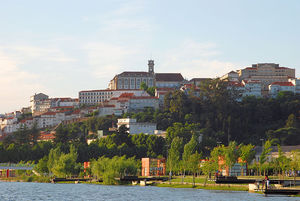 Spread over a hillside beside the river Mondego at the north of the Silver Coast region (195 km north of Lisbon) is Coimbra, which was the country's capital in the 12th Century.
Spread over a hillside beside the river Mondego at the north of the Silver Coast region (195 km north of Lisbon) is Coimbra, which was the country's capital in the 12th Century.
Coimbra is a cultural and educational centre of the country with the University of Coimbra being the oldest academic institution in the Portuguese-speaking world and one of the oldest and most prestigious universities in Europe.
Click images to enlarge.
The traditional fado music, the student and bohemian life, academia and tradition blend with monuments, ancient Roman remains and architecture.
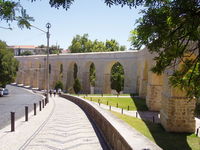 The Roman name for the place now known as Coimbra was Aeminium and there is a well-preserved aqueduct (pictured left) from the Roman city of Civita Aeminium.
The Roman name for the place now known as Coimbra was Aeminium and there is a well-preserved aqueduct (pictured left) from the Roman city of Civita Aeminium.
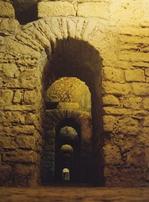
The cryptoporticus, an underground gallery of arched corridors built to support the Roman Forum of the city also survives. (pictured right) Now it is beneath the Bishop's Palace which was built over the forum in the Middle Ages. The cryptoportico can be visited through the Machado de Castro Museum.
The Roman town of Aeminium came under the protection of Conímbriga (15km to the south) until the Germanic Sueves razed Conímbriga in the year 468 when most of the inhabitants fled to Aeminium. It is thought they adapted the name to Coimbra. Today the ruins of Conímbriga are one of the most important and well-preserved Roman ruins anywhere in the Roman world. (see separate article on Conímbriga)

Between 586 and 640, the Visigoths altered the name of the town to Emínio. The Moors occupied Coimbra around the year 711, and made it an important commercial link between the Christian North and Muslim South. The city was reconquered by Ferdinand I of León in 1064 and important archeological remains date from the time when it served as the capital of Portugal (from 1139 to about 1260). In the Late Middle-Ages Coimbra began to evolve into a major cultural centre with the foundation of the University of Coimbra in 1290.
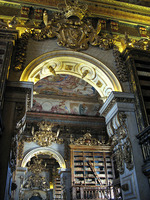
One of the city's most outwardly noticeable landmarks is The Baroque University Tower (Torre da Universidade), built between 1728 and 1733, and pictured left.
Built in the 18th century, the Joanina Library (Biblioteca Joanina pictured right) is a Baroque library in the ancient university
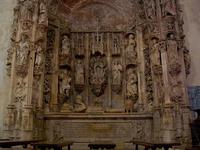
Coimbra was one of the main artistic centres of Portugal during the Age of Discovery (15th and 16th centuries) and many important manueline and renaissance works are to be seen in the town, including the tomb of Kings Afonso Henriques in the Santa Cruz Monastery which is pictured left.

The Baixa (downtown) of Coimbra, pictured on the right, has many cafes and pastry shops.
Coimbra Fado (Fado de Coimbra) is a highly stylized music genre of the traditional Portuguese fado. According to tradition, to applaud fado in Lisbon the audience claps, while in Coimbra one coughs as if clearing the throat.
Coimbra has been called the city of the students or the Lusitan-Athens. It has students from 70 different nationalities. Coimbra is also the place where the oldest students' union of Portugal was founded in 1887.
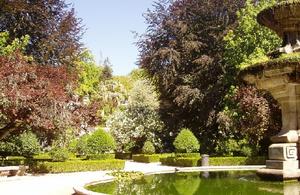
The Botanical Garden of the University of Coimbra is the fifth oldest in the world. The Jardim Botânico was founded in 1772 and then integrated in the Natural History Museum established by the Marquis of Pombal. The area of the Garden has since been enlarged to cover 13 hectares of land, most of which was donated by Benedictinne monks and is considered one of the most beautiful of Europe. The Botanical Garden shelters several species of birds in a natural environment.
Six couples of brown squirrel introduced into the Jardim Botânico in June 1994 have also adapted and bred well since then.
Quinta das Lágrimas, a 19th century palace and estate, which was transformed into a hotel and golf resort, also contains a large park. The "Fonte das Lágrimas" (Fountain of Tears), which according to the legend originated from the tears shed by Inês de Castro when she was killed, is located close to the spring. The entry features a broken arch, probably from the fourteenth century.
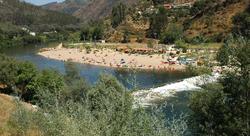
Nearby there are also several picturesque mountain towns such as Lousã and Penacova and spa towns and villages such as Luso, Buçaco and Curia with it's Grande Hotel Da Curia Golf And Spa, Curia.
Without going far from the inner city there are plenty of mountain and river landscapes including the river beach of Palheiros do Zorro in the parish of Torres do Mondego pictured on the right.
Places to Visit - The Silver Coast
Hotels / Villas / Accommodation in Coimbra